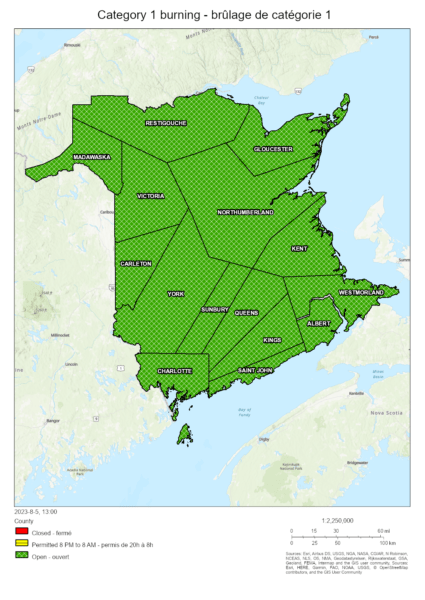Community vows to continue efforts to replace RCMP with a more responsive police force under the municipalities’ control
By Jim Dumville, Local Journalism Initiative Reporter, and Sandra Hanson
New Brunswick Justice and Public Safety Minister Kris Austin rejected Carleton North and Hartland’s proposal to replace the RCMP with a municipal force. Still, the communities will not give up the fight.
“I’m not defeated yet,” said District of Carleton North Coun. Scott Oakes, who chaired the council’s policing committee.
Describing the minister’s rejection as “disappointing,” Oakes said the status quo doesn’t solve existing problems, including lack of police coverage and control of policing costs.
Carleton North Mayor Andrew Harvey announced the minister’s rejection letter at the April 9 council meeting. Like Oakes, he expressed disappointment with the Province’s decision.
“Unfortunately, the issues we have in rural New Brunswick, and specifically the District of Carleton North, are still the same – escalating policing costs with no way to control those costs, a lack of accountability, and a lack of a local detachment,” Harvey told the River Valley Sun.
The mayor pointed to the Province’s planned review of New Brunswick policing standards and services as a reason to hope the rejection is only temporary.
“We stand by our proposal, our business case, and our financial model,” he said. The numbers were solid, and we were ready to go. So now, we’re just waiting.”
In an emailed statement to the River Valley Sun, the Department of Justice and Public Safety said the Province is open to further conversations with the District of Carleton North and the town of Hartland.
Communications Officer Allan Dearing said the department recognizes the high and growing costs of police services throughout the Province.
“Several communities are looking at ways to slow the increases,” he said in the department’s statement.
The statement outlined the high bar municipalities must clear to deliver their own policing service.
“It must be able to operate in accordance with the New Brunswick Policing Standards, policies, and related legislation while showing it can financially maintain and support a police service,” the statement explained.
Oakes believes their proposal met those standards.
“Our proposal wasn’t thrown together in an afternoon, it was months and months of research. We were very honest in our evaluation and budgeted for the worst-case scenario,” Oakes said. “Even with that, we were at or below what we currently pay to the RCMP and the difference would be that we would then have 24-hour coverage and twenty members dedicated to our area.”
However, the proposal didn’t convince department officials or the minister that the communities could deliver a police force at this time, citing cost and staff recruitment as the most significant factors.
“The Department of Justice and Public Safety thoroughly reviewed Hartland and Carleton North’s submission for a potential standalone police force.” the department statement explained. “In addition to increasing costs, recruitment and retention of police officers has been difficult for all police forces across the province and across the country.”
Dearing said the department is open to further discussions.
Oakes disagreed with the department’s reasoning. Not only does Carleton North and Hartland’s municipal police force plan deliver more responsive policing at a lower cost than they currently pay the RCMP, but it also puts costs under control.
“We don’t get to negotiate the contract; we have no say in it – what our services are or the cost. We just pay the bill,” Oakes said.
He said a municipal police force is the only option that allows the district to control policing costs, presence, and visibility.
Oakes acknowledged the two communities cannot afford the transition costs associated with the changeover from the RCMP to a municipal force. The plan asked for the Province to bear those costs.
He explained that the most significant cost of the changeover was establishing headquarters for the new force. The plan called for using Florenceville-Bristol’s former RCMP station, with a satellite office in the former RCMP office in Hartland.
“The biggest expense was the refurbishment of a building for our police station. We didn’t want to burden our taxpayers with that cost. We’re small enough that we hoped the Province would be willing to invest some money with us, in order to make it more equitable for our District and the Town of Hartland,” said Oakes.
He said the need for a new police headquarters points a finger at the RCMP’s shortfall, noting the lack of an RCMP office in either community.
“We were told very clearly by the RCMP that bringing a detachment back to Florenceville is not on the table,” he said. “We asked all those questions before taking the direction we did.”
Oakes said the RCMP currently patrols the two communities, with a population of 13,500, despite no dedicated detachment.
“That is completely unheard of in the rest of Canada,” he said.
The nearest RCMP detachment is in Woodstock. The federal force covers most of Woodstock, except within the boundaries of the former town patrolled by the Woodstock Police Force.
The minister recently accepted Woodstock’s plan to expand the Woodstock Police Force’s coverage to the entire municipality, including $3 million over two years of provincial funds to support the transition.
Woodstock Mayor Trina Jones announced at the April 16 council meeting that the town would study its options, noting the expansion would require a tax hike for taxpayers in the outlying wards.
The Woodstock plan would require the police budget to jump from $3.3 million to $7.7 million and the staff to double.
Oakes also disagreed with public safety officials’ concerns about recruitment challenges.
He dismissed staffing as a significant challenge, noting that several potential recruits had already shown interest. He added that they talked to officers in other areas, hoping to relocate to central and northern Carleton County.
Oakes said the community is on hold as they await a provincewide policing study.












